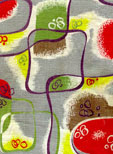
Barkcloth: Then and Now
by Glynis Ward
 |
| Late 50s or early 60s abstract barkcloth. |
Barkcloth, as we know it, is named after the cloth made by indigenous people. True bark cloth is made from fibers pounded out of tree bark and woven into necessary items. It is often marked with tribal designs. The fabric was created in France, where, in the 20s there was a growing interest in tribal art. It was called Cretonne, and made of cotton (sometimes cotton mixed with rayon, which was a very new fabric at the time) - and although it was woven to appear nubby and very natural, it was dyed not with tribal style designs, but with flowers, which were popular.
 |
| A blown up look at the "nub" of barkcloth. It is not barkcloth without this tell-tale nubby look! |
In the late 30s barkcloth was being made in America, and the designs reflected what was popular in décor at the time. Florals, and especially tropicals (which mirrored the rise in interest in both Hawaiian and Japanese cultures) were the earliest motifs. By the 40s, barkcloth was one of the most common fabrics in the home. It covered all manner of furniture, and was made into window coverings. Just about any design imaginable was either printed, or vat dyed: tropicals, leaves, birds, scenes from romantic countries, old fashioned scenes, wild abstract shapes, children's prints, animals, subtle and delicate florals... during the 50s, barkcloth was absolutely indispensable!
 |
| Mid-50s barkcloth with combination tropical and Asian motifs. |
By the 60s, more and more manmade fibers were used in décor items. Barkcloth was seen less frequently in the home, although it was still a popular fabric in Hawaiian clothing. During the early 70s some barkcloth was still manufactured in the US, but it quickly disappeared. But during the 80s, with the rise in interest in popular culture of the past, barkcloth once again became desirable. Several companies began to manufacture barkcloth once again, making sure that the motifs were as authentic as the fabric.
|
Vintage barkcloth is usually found in the form of drapery. If barkcloth is being sold by the yard, and is very bright and new looking, it's probably a reproduction (which is great if you need durability!). When buying vintage barkcloth make sure the piece suits your needs. If you are making pillow shams - save money by buying a piece with holes, used as a "cutter". Check for fading and dry rot. You can still use barkcloth, which has been faded, and has minor dry rot, but you shouldn't pay very much for it.
 |
| Mid 50s barkcloth combination of metallics with abstract and geometric shapes. The even yellow coloring is a sign that mild dry rot has set in. |
Here are a few ideas that can help you salvage a piece of fabulous but damaged barkcloth!
Cover a vintage purse!
Do you have a sturdy "Jackie O" style vintage purse, which is damaged? Then, cover it with a hunk of barkcloth! Use the purse as a pattern, and hot glue the fabric to the outside of the purse, turning under the edges. Cover the handle if you like (or replace it with a piece of chain if it is damaged or doesn't match)...these are really unique!
Dry Rot Runners!
Some barkcloth is just too cool to pass up! If you have a piece with dry rot, but it has no holes or major discolorations, you can still use it in your décor! It is best to sandwich this furniture runner or "table top cover" between glass and the top of your piece of furniture - this deters further damage. Have glass cut to the dimensions of your table top. Use the glass piece as a template to cut both your fabric, and an acid-free piece of thin carding. Cut the carding the exact size of the glass. Cut the fabric about an inch larger than the glass, on all sides. Using spray on fabric glue, spray the carding top with glue. Center the fabric on top, and smooth it out very carefully. Let the glue set. Flip the fabric/carding over, and cut a "v" in each corner, almost to the carding. Carefully spray glue down each side of the fabric (if you are making a circular pattern, you will have to cut a "v" every few inches). Let it dry. Set the runner under your glass on top of your table.
More barkcloth photos:
|
|
|
|
All information presented herein is provided for entertainment purposes only. CoolOldStuff.com and Relicorp, Inc. (hereafter known as the Companies) are in no way affiliated or associated with eBay TM. Further, eBay TM has not endorsed or authorized the use of the data presented in any graphs which may be presented herein.
All materials contained in this Web site are protected by copyright laws, and may not be reproduced, republished, distributed, transmitted, displayed, broadcast or otherwise exploited in any manner without express prior written permission.
To the maximum extent permitted by applicable law, the officers, agents, employees and other representatives of the Companies further disclaim all warranties, expressed or implied, including warranties of merchantability and fitness for a particular purpose. The Companies further disclaim any legal liability or responsibility for the accuracy, completeness, or usefulness of any information, apparatus, product, or process disclosed on the server. Companies do not represent that the use of any such document, information, apparatus, product or process will not infringe privately owned rights. To the maximum extent permitted by applicable law, in no event shall Companies be liable for any consequential, incidental, direct, indirect, special, punitive, or other damages whatsoever (including, without limitation, damages for loss of profits, business interruption, loss of business information, or other pecuniary loss) arising out of this agreement.
contact | privacy | about us

© Copyright CoolOldStuff 1998-2004



